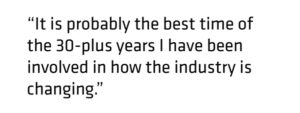GC: How did you start your career in finance and securities services?
Justin Chapman: I started on the equity trading floor at 15 back in the late 1980s. It was also a family thing as my father was also a trader at the time. I left school before the exams, went and started there and was trading by the time I was 17. So my foundation was in securities, and I had an early understanding of how equities were structured. It was very useful to have that experience on the front-end, as well as seeing how the markets became automated in the 1990s and apply it to securities services.

GC: How did you make the journey from the front to the back-office?
JC: From the trading floor, I then ran trading IT where I looked after the implementation of trading technology. I then joined a consultancy and worked around investment banking and the outsourcing of trading IT, so I was very much involved in the product side. Off the back of that, I set up two software companies which I then sold in the late 90s and then retired in 2000 for a couple of years. I was then approached by one of the software companies I was working with, that was focused on corporate actions at the time. Northern Trust also approached me about helping them with some of their large change initiatives in the back-office. I wanted the intellectual challenge so I joined them in 2004 and ended up running their global change management organisation, which was aligned with the global business leads in terms of large implementation of technology and change initiatives.
I then took over the income tax operations business for them, in addition to change management. We ran about 700 people in those groups, and a lot of that was repositioning staff appropriately to maximise efficiency, and implementing the technology to enable those controls and processes to be more global. That was a great chunk of my time at Northern until seven years ago when I became more heavily involved in the regulatory and market advocacy side, and more on the innovation side. We started looking at opportunities off the back of the regulation after we did the implementation. That morphed into the market advocacy role I still run today, as well as the securities services business, where we try to make sure we look at the future of business models and opportunities outside of the regulation. It has been a transition from operations to the product and design of the business, and working with the market, clients, participants and regulators to look at how we evolve market structure.
GC: What were some of the large change initiatives you were involved in?
JC: I have been involved in from some of the projects that didn’t happen such as GSTPA (the Global Straight Through Processing Association), moving to the large implementation of CREST in the UK and T2S in Europe. We are now heavily focused on the digitisation of the market. Having a lot of operations, product, technology and markets experience, the logical move into running the securities services business was quite logical. We are looking to digitise the custody business and look at those opportunities, so I have been involved in planning that out and how it will look in the future. This is probably the most interesting decade of the area we are moving into, and it is a great opportunity to combine the innovation and securities business.
GC: How does having a global perspective help you evolve the business?
JC: Our clients and market infrastructures are regional, and all have a slightly different lens. In the developing markets where they are more nimble, we have learnt a lot which can be brought into the more established markets. Some of the developed markets are more forward thinking in terms of new technology adoption and willingness to change, but at the same time they don’t have the same regulatory governance structure of the established markets. So bringing them together and having a level playing field is interesting and key for us to normalise these markets and create channels for our clients.
The East-to-West dynamic is very interesting. Going from China which is very omni-channel, very government-driven and very quick to adopt new opportunities, but from a global perspective it is very different in terms of data privacy laws in the US or Europe. You need to be cognisant of how the dynamics in the markets are affected and how they are being implemented. It is probably the best time of the 30-plus years I have been involved in how the industry is changing, and the change has been the most accelerated over the last three years.
GC: What initiatives are you focused on and what one’s have the most potential?
JC: One of the key objectives from the senior management is how do we digitise our business. That can be from the digitisation of data to driving significant market changes where it can change the current business and operating model. We are backing good initiatives anywhere in the world that furthers our digital agenda. Part of our architecture is event-driven which enables that from a technology perspective, and it is bringing everything together into the new digital market, the new digital custody business that we think will be around in the coming years.
We are in 103 markets, and we know there are probably 10 markets that we think digitisation will move quicker in, so it is investing in those markets and then relaying it back into other areas.